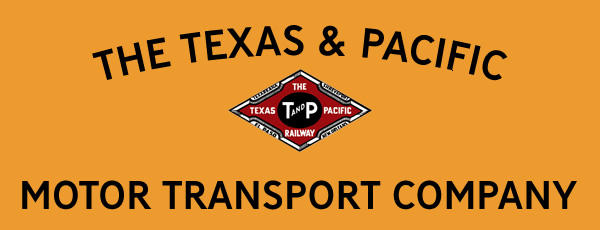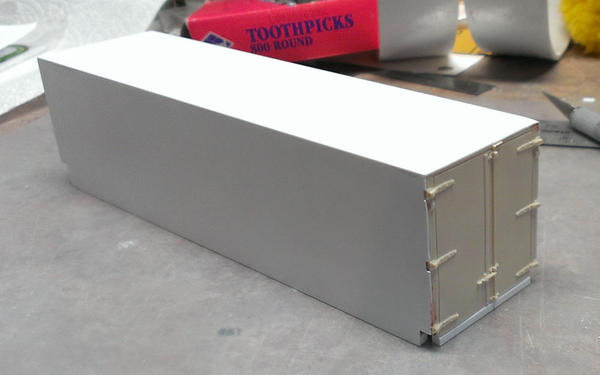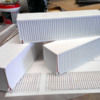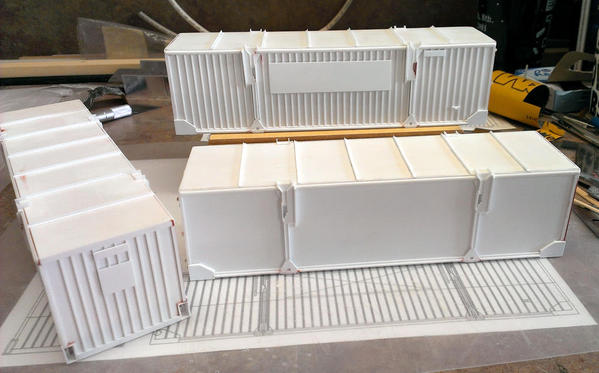Now that I am on the home stretch, I would like to share my current scratch build project to make three Missouri Pacific / Texas & Pacific Demountable Containers, circa mid/late '50’s to early ‘60’s.
A little history on these containers… While the MoPac embraced TOFC operations, they were also an early pioneer of COFC operations. In the early to mid 1950’s, the MoPac built their own shipping containers that were 32’ long and 8’-6” high. Their reasoning for COFC was simple. Why increase the freight tonnage you had to haul by also shipping the trailer chassis, when it was only the container loaded with goods that needed to be moved. They designed their new contaIners so that they could be transported on flat cars or in gondolas with minimal or no special features needed on these cars. Each corner of the container had a reinforced pocket that contained a clevis that would be used to secure the container to the freight car decking with chains. Some of these containers were also fitted with air conditioning units to provide cooling inside of the container. Later in the mid 1960’s, the MoPac switched from building their own containers to purchasing 37’ long aluminum bodied units built by Trailvan.
The Missouri Pacific COFC service started on the route between St. Louis and Kansas City in the mid 1950’s, and quickly spread throughout their rail system. Each of their main freight hubs had LeTourneau Cranes purchased and installed to load / unload these containers. The COFC concept also migrated to their subsidiary, the Texas and Pacific. In 1956, the MoPac was invited to join Trailer Train operations along with SLSF, the PRR, and N&W. The MoPac containers were carried on TTX 85’ long flatcars.
In the area that I am modeling, the Lower Rio Grande Valley in Texas, MoPac containers were loaded with citrus and fresh fruits and vegetables and hauled to major freight terminals like St. Louis. The containers were unloaded off the flatcars and gondolas, and placed on trailer chassis. These trailers were then trucked to regional and local markets. The empty containers were then brought back to the freight terminal and reloaded with mail and other LTL goods, and made the return trip to South Texas as head end cars in passenger service or in dedicated mail trains.
I have been researching and gathering photos and information on these containers for well over a year. I was able to find about 15 unique photos of these containers. Below are some sample images I found or scanned from old trade magazines.
From these images, and working with the 8’-6” height and 32’ container length as my known dimensions, I scaled the components making up these containers and their locations, and put together a scaled drawing of the container in AutoCAD. I know I may be an inch off here or there, but I believe that I am at least 95% accurate with my drawing. There are a few items that are so small that they don’t show up clear enough in photos to be able to make an 100% accurate estimation of their size and shape. In these cases, I used my past experience in steel fabrication to make reasonable assumptions of how they were fabricated. Below is the drawing views I created.
Additionally, I created some artwork that will be used for decals. As is typical for a lot of the “hand stylized” fonts used in railroad heralds and text, there are not any fonts available that exactly matched the style used on these containers. I ended up using several different fonts that were really close, and altered them by condensing or stretching the fonts, and changing their kerning to get them as close as possible to the actual style I was trying to match.
For the doors end of the container, I found a trailer kit that had a door panel that was pretty close to what was used on these containers. I made a RTV mold, and cast several of these end door panels in Alumilite.
For the container, I started with a 2” x 2” balsa block to use as my core. I glued 1/8” square styrene around the perimeter of the bottom of the block to build it up to the 8’-6” scaled height. The corners were cut back for the future corner pockets. I then glued my cast end doors panel to the balsa block.
I then skinned the balsa block with .020” thick styrene. Next I added .030” styrene strip stock on the sides of the containers to form the top / bottom / side sills. [Not shown in the photos below, but shown in other progression photos.]
The T&P container had smooth sides. However, the MoPac containers had ribbed corrugations on the front and side panels. To make the ribs, I used .030 square strip stock. I used the following method to make applying these ribs as easy as possible, with the ribs on the proper centers, and as straight and parallel as possible. I took a sheet of clear .010 plastic, and cut it to the exact dimensions of the sides and front of the container. I taped the clear sheet over a printed copy of my scaled drawing. I then applied two strips of double-sided tape, side-by-side, down the length of the clear sheet. Next I carefully set the .030” square strips over the locations on drawing, and cut the length of each strip to match. When finished, I laid my metal ruler 90-degrees to the strips, and pressed down to make sure that they were firmly taped down to the clear sheet.
Next I placed the clear sheet with the taped rib strips onto the side of the container, and made sure that the clear sheet was exactly aligned with the container outside edges. I then taped the long side of the clear sheet to the top side of the container to make a “hinge”. I then swung the clear sheet with taped ribs down, and carefully applied CA glue to each individual strip. You have to work quickly to make sure that the glue does not dry and set up before you get glue applied to every strip. With glue applied, I then simply swung the clear sheet back up from the hinged side, and pressed down on the strips to make sure that they were all glued onto the container. Next, I removed the tape “hinge” and carefully peeled the clear sheet off the glued ribs. This process was repeated for each container side and the front.
With the ribs glued down, it was now time to make the LeTourneau Crane “pockets”, for a lack of a more correct term. These are the pockets that the crane’s straddle hooks would drop into. Each pocket was made up from sixteen (16) individual pieces of cut styrene, ranging from .010 to .030 thick. Working off my scaled drawing, I printed paper patterns for each piece, double-sided taped them onto the proper thickness of styrene, and hand cut them using a straight razor blade. It is a little hard to see, but the top “V” used to help guide the crane hooks into the pocket is angled back to contact the top edge of the container.
I am now working on all of the additional pieces to complete each container... Roof stiffener angles, herald / text boards, and the “I-believe-will-be-pesky” working clevis’s for each container lower corner pocket. After that it will be prep for painting, painting, and decaling. I’ll post update photos as I move through and complete these phases.














































